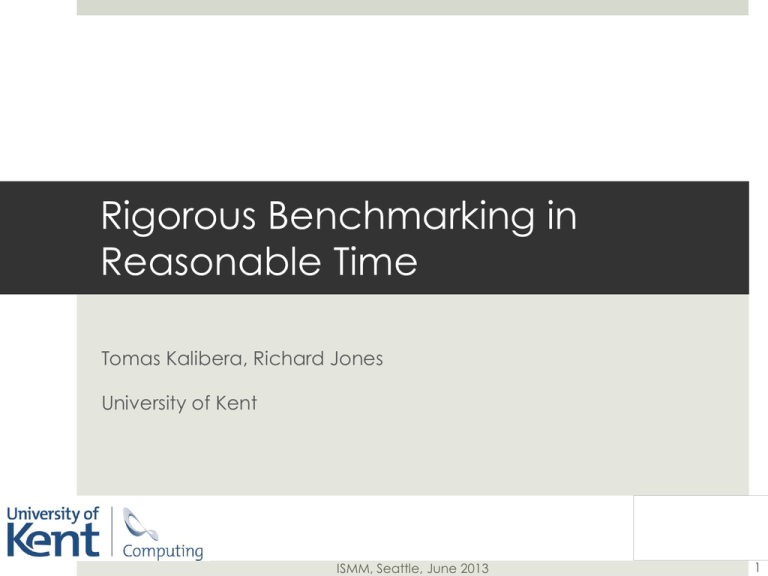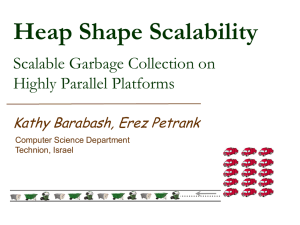Can you trust your experimental results?
advertisement

Rigorous Benchmarking in Reasonable Time Tomas Kalibera, Richard Jones University of Kent ISMM, Seattle, June 2013 1 What do we want to establish? By comparing an old and a new system rigorously, find If there is a performance change? How large is the change? new execution time old execution time What variation we expect? How confident are we of the result? How many experiments must we carry out? ISMM, Seattle, June 2013 2 Uncertainty Computer systems are complex. Many factors influence performance: Some known. Some out of experimenter’s control. Some non-deterministic. Execution times vary. We need to design experiments and summarise results in a repeatable and reproducible fashion. ISMM, Seattle, June 2013 3 Uncertainty should be reported! 140 120 100 Papers (122) 80 Execution time (67) 60 Execution time ratio (59) 40 Ignored uncertainty (47) 20 0 Papers published in 2011 ISMM, Seattle, June 2013 4 Uncertainty should be reported! 140 120 100 80 60 40 ignored Execution time (67) uncertainty Execution time ratio (59) Papers (122) Ignored uncertainty (47) 20 0 Papers published in 2011 ISMM, Seattle, June 2013 5 How were the experiments performed? Not always obvious if experiments were repeated. Very few report that experiments repeat at more than one level, e.g. Repeat executions (e.g. invocations of a JVM). Repeat measurements (e.g. iterations of an application). Number of repetitions: arbitrary or heuristic-based? ISMM, Seattle, June 2013 6 One benchmark… Good experimental methods take time ISMM, Seattle, June 2013 7 A suite… Good experimental methods take time ISMM, Seattle, June 2013 8 Add invocations… Good experimental methods take time ISMM, Seattle, June 2013 9 and iterations… Good experimental methods take time ISMM, Seattle, June 2013 10 …and heap sizes Good experimental methods take time ISMM, Seattle, June 2013 11 A lost cause? Is statistically rigorous experimental methodology simply infeasible? ISMM, Seattle, June 2013 12 NO! With some initial one-off investment, We can cater for variation Without excessive repetition (in most cases). Our contributions: A sound experimental methodology that makes best use of experiment time. How to establish how much repetition is needed. How to estimate error bounds . ISMM, Seattle, June 2013 13 The Challenge of Reasonable Repetition Variation at several stages of a benchmark experiment — iteration, execution, compilation… Controlled variables platform, heap size or compiler options. Random variables statistical properties. Uncontrolled variables try to convert these to controlled or randomised (e.g. by randomising link order). The challenge: How to design efficient experiments given the random variables present, and Summarise the results, with a confidence interval. ISMM, Seattle, June 2013 14 Our running example An experiment with 3 “levels” (though our technique is general): 1. Repeat compilation to create a binary — e.g. if code performance depends on layout. 2. Repeat executions of the same binary. 3. Repeat iterations of a benchmark. ISMM, Seattle, June 2013 15 Independent state Researchers are typically interested in steady state performance. Initialised state: no significant initialisation overhead. Independent state: iteration times are (statistically) independent and identically distributed (IID). Don’t repeat measurements before independence. If measurements are not IID, the variance and confidence interval estimates will be biased. ISMM, Seattle, June 2013 17 Independent state Does a benchmark reach an independent state? After how many iterations? DaCapo/OpenJDK 7: ‘large’ and ‘small’ sizes 3 executions, 300 iterations/execution. Inspect run-sequence, lag and auto-correlation plots for patterns indicating dependence. 3.0 2.5 ● ●● ●● ● ● ●● ● ● ● ● ● ●● ● ● ● ● 1.0 1.5 ● ● ● ● ● ● ● ● ● ● ●●● ● ● ● ● ● ●● ● ● ●●● ●●● ● ●● ●● ●● ● ● ●●●●●● ●●● ●●●● ● ● ● ●● ●●●●● ● ● ● ●● ● ●●●●●● ●● ●● ●● ● ● ●● 2.0 2.5 3.0 ● ● ● ● ● ● ● ● ● ● ● ● ● ● ● ●● ● ● ●● ● ● ● ● ● ● ● ● ● ● ● ● ● ● ● ● ● ● ● ● ● ● ● ● ●● ● ● ● ● ● ● ● ● ● ●● ● ●● ● ● ● ● 1.5 ● ● ● ● ● ●● ● ● ● ● ● ● ● ● ●● ● ● ● 2.0 ● 2.0 1.5 ● ● ● ● ● ● ● ● ●●●● ● ●●● ● ●● ● ● ●●●● ●● ● ● ● ●● ● ● ● ●● ● ● ● ●●● ●●● ● ● ● ●● ● ● ●●●● ●●● ●●●●●● ●●●● ●●●● ●●● ●● ● ●● ● ●● ● ● ● ●●● ● ● ● ● ● ● ●● ● ● ● ● ● ●● ● ● ● ● ● ●● ● ●● ● ●● ● ● ● ● ● ●● ● ●● ● ●● ● ● ● ● Time [s] 2.5 ● ●● ●● ● ● ●● ● ●● ● ● ● ● ● ● ● 1.0 Time [s] ● ● 1.0 3.0 ● ● ● ●● ●● ● ● ● ●●● ● ●● ●● ● ●● ● ● ● ●●●● ● ● ●● ●● ● ●● ● ● ● ● ● ● ● ● ● ● ● ● ● ● ●● ●● ● ● ● ● ● ● ●●●● ● ●● ●● ● ● ● ● ● ● ● ● ● ● ● ● ● ● ● ● ● ●● ● ●● ● ● ● ● ● ● ● ● ●● ● ● ● ● ● ● ● ●● ●● ● ● ● ● ●● ●●● ●● ● ● ●●● ● ● ●● ●● ● ● ●●● ● ●● ●● ● ●● ●●● ●● ● ● ●● ● ● ●● ●● ● ● ● ● ●● ● ● ● ● 1.0 LAG 1 of Time [s] ● ● ● 1.5 ● ● ● ● ● ●● ● ● ● ● ● ● ● ● ● ●● ● ● ● ●● ● ● 2.0 ● ● ● ● ● ● ●● ● ● ● ● ● ● ● ● ● 2.5 ● ●● ● ● ● ●● ●● ● 3.0 LAG 1 of Time [s] ISMM, Seattle, June 2013 18 Independent state Does a benchmark reach an independent state? After how many iterations? DaCapo/OpenJDK 7: ‘large’ and ‘small’ sizes RECOMMENDATION: Use this manual 3 executions, 300 iterations/execution. procedure just once to find how many Inspect run-sequence, lag and auto-correlation plots for iterations each benchmark, VM and patterns indicating dependence. platform combination requires to reach an independent state. 3.0 2.5 ● ●● ●● ● ● ●● ● ● ● ● ● ●● ● ● ● ● 1.0 1.5 ● ● ● ● ● ● ● ● ● ● ●●● ● ● ● ● ● ●● ● ● ●●● ●●● ● ●● ●● ●● ● ● ●●●●●● ●●● ●●●● ● ● ● ●● ●●●●● ● ● ● ●● ● ●●●●●● ●● ●● ●● ● ● ●● 2.0 2.5 3.0 ● ● ● ● ● ● ● ● ● ● ● ● ● ● ● ●● ● ● ●● ● ● ● ● ● ● ● ● ● ● ● ● ● ● ● ● ● ● ● ● ● ● ● ● ●● ● ● ● ● ● ● ● ● ● ●● ● ●● ● ● ● ● 1.5 ● ● ● ● ● ●● ● ● ● ● ● ● ● ● ●● ● ● ● 2.0 ● 2.0 1.5 ● ● ● ● ● ● ● ● ●●●● ● ●●● ● ●● ● ● ●●●● ●● ● ● ● ●● ● ● ● ●● ● ● ● ●●● ●●● ● ● ● ●● ● ● ●●●● ●●● ●●●●●● ●●●● ●●●● ●●● ●● ● ●● ● ●● ● ● ● ●●● ● ● ● ● ● ● ●● ● ● ● ● ● ●● ● ● ● ● ● ●● ● ●● ● ●● ● ● ● ● ● ●● ● ●● ● ●● ● ● ● ● Time [s] 2.5 ● ●● ●● ● ● ●● ● ●● ● ● ● ● ● ● ● 1.0 Time [s] ● ● 1.0 3.0 ● ● ● ●● ●● ● ● ● ●●● ● ●● ●● ● ●● ● ● ● ●●●● ● ● ●● ●● ● ●● ● ● ● ● ● ● ● ● ● ● ● ● ● ● ●● ●● ● ● ● ● ● ● ●●●● ● ●● ●● ● ● ● ● ● ● ● ● ● ● ● ● ● ● ● ● ● ●● ● ●● ● ● ● ● ● ● ● ● ●● ● ● ● ● ● ● ● ●● ●● ● ● ● ● ●● ●●● ●● ● ● ●●● ● ● ●● ●● ● ● ●●● ● ●● ●● ● ●● ●●● ●● ● ● ●● ● ● ●● ●● ● ● ● ● ●● ● ● ● ● 1.0 LAG 1 of Time [s] ● ● ● 1.5 ● ● ● ● ● ●● ● ● ● ● ● ● ● ● ● ●● ● ● ● ●● ● ● 2.0 ● ● ● ● ● ● ●● ● ● ● ● ● ● ● ● ● 2.5 ● ●● ● ● ● ●● ●● ● 3.0 LAG 1 of Time [s] ISMM, Seattle, June 2013 19 Reached independent state? DaCapo ‘small’ avrora9 h29 pmd6 pmd9 bloat6 hsqldb6 sunflow9 eclipse6 fop6 chart6 eclipse9 fop9 jython6 luindex6 jython9 luindex9 lusearch9 tomcat9 tradebeans9 xalan6 tradesoap9 xalan9 Intel Xeon: 2 processors x 4 cores x 2-way HT ISMM, Seattle, June 2013 20 Reached independent state? DaCapo ‘small’ avrora9 h29 pmd6 pmd9 bloat6 hsqldb6 sunflow9 eclipse6 fop6 chart6 eclipse9 fop9 jython6 luindex6 jython9 luindex9 lusearch9 tomcat9 tradebeans9 xalan6 tradesoap9 xalan9 AMD Opteron: 4 processors x 16 cores ISMM, Seattle, June 2013 21 Reached independent state? DaCapo ‘large’ avrora9 h29 pmd6 pmd9 bloat6 hsqldb6 sunflow9 eclipse6 fop6 chart6 eclipse9 fop9 jython6 luindex6 jython9 luindex9 lusearch9 tomcat9 tradebeans9 xalan6 tradesoap9 xalan9 Intel Xeon: 2 processors x 4 cores x 2-way NT ISMM, Seattle, June 2013 22 Reached independent state? DaCapo ‘large’ avrora9 h29 pmd6 pmd9 bloat6 hsqldb6 sunflow9 eclipse6 fop6 chart6 eclipse9 fop9 jython6 luindex6 jython9 luindex9 lusearch9 tomcat9 tradebeans9 xalan6 tradesoap9 xalan9 AMD Opteron: 4 processors x 16 cores ISMM, Seattle, June 2013 23 Reached independent state? DaCapo ‘small’ avrora9 h29 pmd6 pmd9 bloat6 hsqldb6 sunflow9 eclipse6 fop6 chart6 eclipse9 fop9 jython6 luindex6 jython9 luindex9 lusearch9 tomcat9 tradebeans9 xalan6 tradesoap9 xalan9 AMD Opteron: 4 processors x 16 cores ISMM, Seattle, June 2013 24 Some benchmarks don’t reach independent state Many benchmarks do not reach an independent state in a reasonable time. Most have strong auto-dependencies. Gradual drift in times and trends (increases and decreases); abrupt state changes; systematic transitions. Choice of iteration significantly influences a result. Problematic for online algorithms which distinguish small differences although the noise is many times larger. Fortunately, trends tend to be consistent across runs. ISMM, Seattle, June 2013 25 Some benchmarks don’t reach independent state Many benchmarks do not reach an independent state in a reasonable time. Most have strong auto-dependencies. Gradual drift in times and trends (increases and decreases); abrupt state changes; systematic transitions. RECOMMENDATION: If a benchmark does not reach an independent state in a reasonable time, Problematic for online algorithms which distinguish small take the samethe iteration fromtimes each run. differences although noise is many larger. Choice of iteration significantly influences a result. Fortunately, trends tend to be consistent across runs. ISMM, Seattle, June 2013 26 Heuristics don’t do well Initialised Independent Harness Georges bloat 2 4 8 ∞ chart 3 4 1 eclipse 5 7 7 4 fop 10 180 7 8 hsqldb 6 6 8 15 jython 3 5 2 luindex 13 4 8 lusearch 10 7 8 pmd 7 4 1 xalan 6 15 139 85 13 ISMM, Seattle, June 2013 27 Heuristics don’t do well Initialised Independent Harness Georges bloat 2 4 8 ∞ chart 3 4 1 eclipse 5 7 7 4 fop 10 180 7 8 hsqldb 6 6 8 15 jython 3 5 2 luindex 13 4 8 lusearch 85 7 8 pmd 10 Wastes time! 7 4 1 xalan 6 13 15 139 ISMM, Seattle, June 2013 28 Heuristics don’t do well Initialised Independent Harness Georges bloat 2 4 8 ∞ chart 3 4 1 eclipse 5 7 7 4 fop 10 180 7 8 hsqldb 6 6 8 15 jython 3 5 2 luindex 13 4 8 lusearch 10 7 8 pmd 7 4 1 xalan 6 15 139 85 13 Unusable! ISMM, Seattle, June 2013 29 Heuristics don’t do well Initialised Independent Harness Georges bloat 2 4 8 ∞ chart 3 4 1 eclipse 5 7 7 4 fop 10 180 7 8 hsqldb 6 6 jython 3 luindex 13 lusearch 10 pmd 7 xalan 6 Initialised in8 reasonable5 time 85 13 ISMM, Seattle, June 2013 15 2 4 8 7 8 4 1 15 139 30 What to repeat? Run a benchmark to independence and then repeat a number of iterations, collecting each result? or Repeatedly, run a benchmark until it is initialised and then collect a single result? The first method saves experimentation time if variation between iterations > variation between executions, initialisation warmup + VM initialisation is large, and independence warmup is small. Variation % bloat6 eclipse9 lusearch9 xalan6 xalan9 Iteration 14.1 0.8 3.3 7.0 3.5 Execution 3.7 0.4 30.3 9.1 1.0 AMD Opteron: 4 processors x 16 cores ISMM, Seattle, June 2013 31 What to repeat? Run a benchmark to independence and then repeat a number of iterations, collecting each result? or Repeatedly, run a benchmark until it is initialised and then collect a single result? The first method saves experimentation time if variation between iterations > variation between executions, initialisation warmup + VM initialisation is large, and independence warmup is small. Variation % bloat6 eclipse9 lusearch9 xalan6 xalan9 Iteration 14.1 0.8 3.3 7.0 3.5 Execution 3.7 0.4 30.3 9.1 1.0 AMD Opteron: 4 processors x 16 cores ISMM, Seattle, June 2013 32 A clear but rigorous account Goal: We want to quantify a performance optimisation in the form of an effect size confidence interval, e.g. “we are 95% confident that system A is faster than system B by 5.5% ± 2.5%”. We need to repeat executions and take multiple measurements from each. For a given experimental budget, we want to obtain the tightest possible confidence interval. Adding repetition at the highest level always increases precision. but it is often cheaper to add repetitions at lower levels. ISMM, Seattle, June 2013 33 Multi-level repetition How many repetitions to do at which levels? 1. Run an initial, dimensioning experiment Gather the cost of a repetition at each level. Iteration — time to complete an iteration. Execution — more expensive, need to get to an independent state. Calculate optimal repetition counts for the real experiment. 2. Run the real experiment. Use the optimal repetition counts from the initial experiment. Calculate the effect size confidence interval. ISMM, Seattle, June 2013 34 Initial Experiment Initial experiment Choose arbitrary repetition counts r1,…,rn 20 may be enough, 30 if possible, 10 if you must (e.g. if there are many levels) Then, measure the cost of each level, e.g. c1 time to get an iteration (iteration duration). c2 time to get an execution (time to independent state). c3 time to get a binary (build time) . Also take the measurement times Yjn...j1 Y2,1,3 = time of the 3rd non-warmup iteration from the 1st execution of the 2nd binary. ISMM, Seattle, June 2013 35 Initial Experiment Variance estimators First calculate n biased estimators S12,…,Sn2 Then the unbiased estimators Ti2 iteratively ISMM, Seattle, June 2013 36 Initial Experiment Variance estimators First calculate n biased estimators S12,…,Sn2 Then the unbiased estimators Ti2 iteratively ISMM, Seattle, June 2013 37 Real Experiment Optimal repetition counts The optimal repetition counts to be used in the real experiments are r1,…,rn-1 We don’t calculate rn, the repetition count for the highest level rn can always be increased for more precision. Calculate the variance estimators Sn2 for the real experiment as before but using the optimal repetition counts r1,…,rn-1 and the measurements from the real experiment. ISMM, Seattle, June 2013 38 Real Experiment Confidence intervals Asymptotic confidence interval with confidence (1 − a) where is the (1-a/2)-quantile of the I-distribution with n = rn-1 degrees of freedom. See the ISMM’13 paper for details of constructing confidence intervals of execution time ratios. See our technical report for proofs and gory details. ISMM, Seattle, June 2013 39 Confidence interval for execution time ratios Confidence interval due to Fieller (1954). and are average execution times from the old and new systems. Variance estimators Sn2 and S’n2 and half-widths h,h’ as before. ISMM, Seattle, June 2013 40 In practise For each benchmark/VM/platform… Conduct a dimensioning experiment to establish the optimal repetition counts for each but the top level of the real experiment. Redimension if only if the benchmark/VM/platform changes. ISMM, Seattle, June 2013 41 DaCapo (revisited) bloat6 lusearch9 xalan6 xalan9 c1(s) 35.5 1.7 10.8 6.7 c2(s) 110.0 12.3 3.4 30.2 10 1 2 15 Optimal (%) 14.0 3.4 7.2 3.5 Original (%) 14.1 3.3 7.0 3.5 r1 Halfintervals AMD Opteron: 4 processors x 16 cores The confidence half-intervals using optimal repetition counts correspond closely to those obtained by running large numbers of executions (30) and iterations (40). But repetition counts are much lower. E.g. lusearch: r1=1 so time better spent repeating executions ISMM, Seattle, June 2013 42 Conclusions Researchers should provide measures of variation when reporting results. DaCapo and SPEC CPU benchmarks need very different repetition counts on different platforms before they reach an initialised or independent state. Iteration execution times are often strongly autodependent: for these, automatic detection of steady state is not applicable. They can waste time or mislead. An one-off (per benchmark/VM/platform) dimensioning experiment can provide the optimal counts for repetition at each level of the real experiments. ISMM, Seattle, June 2013 43 RECOMMENDATION: Benchmark developers should include our dimensioning methodology as a one-off, per-system configuration requirement. ISMM, Seattle, June 2013 44 ISMM, Seattle, June 2013 45 Code layout experiments ISMM, Seattle, June 2013 46 What’s of interest? Mean execution times Minimum threshold for ratio of execution times Only interested in ‘significant’ performance changes Improvements in systems research are often small, e.g. 10%. Many factors influence performance E.g. memory placement, randomised compilation algorithms, JIT compiler, symbol names… [Mytkowicz et al., ASPLOS 2009; Gu et al, Component and middleware performance workshop 2004] Randomisation to avoid measurement bias E.g. Stabiliser tool [Curtsinger & Berger, UMass TR, 2012] ISMM, Seattle, June 2013 47 Current best practice Based on 2-level hierarchical experiments Repeat measurements until standard deviation of last few measurements is small enough. Quantify changes using a visual or statistical significance test [Georges et al, OOPSLA 2007; PhD 2008] Problems Two levels are not always appropriate Null hypothesis significance tests are deprecated in other sciences Visual tests are overly conservative ISMM, Seattle, June 2013 48 Null hypothesis significance tests Null hypothesis: “the 2 systems have the same performance” Tests if the null hypothesis can be rejected: “it is unlikely that the systems have the same performance” Student’s t-test Visual test ISMM, Seattle, June 2013 49 Visual test Construct confidence intervals Do they overlap? If not, it is unlikely that the systems have the same performance [If only slight overlap — centre not covered by other CI — fall back to statistical test] ISMM, Seattle, June 2013 50 What’s wrong with this? 1. It does not tell us what we want to know Only if there is a performance change We could also report the ratio of sample means But we still don’t know how much of this change is due to uncertainty 2. The decision is affected by sample size The larger the sample, the more unlikely even a small and meaningless change becomes Its limitations have been known for 70 years Deprecated in many fields: statistics, psychology, medicine, biology, chemistry, sociology, education, ecology… ISMM, Seattle, June 2013 51 What’s wrong with this (cont.)? 3. Both tests use parametric methods that violate their assumptions Performance measurements are not usually normally distributed Multi-modal, long tails to the right Good practice to check if data is close to normal Robust methods are used in some fields Should at least make assumptions clear That using Student’s t-test is OK… …Often it is OK ISMM, Seattle, June 2013 52 Two methods Statistical model of random effects in n-way classification Use this model to construct effect size confidence interval for the ratio of the means of execution time. 1. A parametric method based on asymptotic normality 2. A non-parametric method based on statistical simulation (‘bootstrap’) ISMM, Seattle, June 2013 53 Quantifying the performance (1) Parametric method Use the same number of repetitions for the old (OY) and new (NY) system. Report (1-a) confidence interval (e.g. a=0.05 for 95% CI) ta/2,n denotes the a/2-quantile of the t-distribution with n = nn+1 - 1 degrees of freedom ISMM, Seattle, June 2013 54 Quantifying performance (2) Bootstrap method 1. Perform many simulations (1000 or more if there is time) Use real data within each simulated step 2. Randomly choose the values to use at each level Replacement at all levels seems safe 3. Calculate many sample means from these Asymptotically normal due to the Central Limit Theorem Form a (1-a) CI by using the a/2 and 1-a/2 sample quantiles E.g. order the values and use the 25th and 975th ISMM, Seattle, June 2013 55 Parametric vs. bootstrap Bootstrap is more robust than parametric method Uses fewer assumptions Does not depend on underlying distribution No need to check if data is reasonably close to normal Can be used with other metrics, e.g. medians Parametric method is more confident Narrower confidence intervals More likely to find a significant difference ISMM, Seattle, June 2013 56









